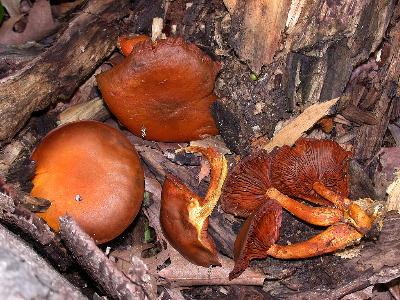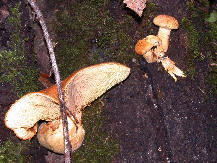by Kelsea Jewell and Tom Volk
It's my 100th Fungus of the Month!
Please click TomVolkFungi.net for the rest of Tom Volk's pages on fungi

Psilocin is usually in extremely low concentration, if present at
all, in G. spectabilis, and is a dephosphorylated psilocybin (note the
major change between the two structure is the replacement of that large P and O
group with a simple OH). Ingested psilocybin is converted in human systems into
psilocin by enzymatic dephosphorylation (i.e. the removal of a phosphate group).
In pure form, both compounds are crystals, but psilocybin is
stable and readily soluble in water while psilocin is prone to oxidation (the
removal of an electron) and is poorly soluble in water. The dose at which 50 %
of test organisms die (LD50) for psilocybin is quite low at 280 mg/kg
for mice, and theoretically the same values would apply to humans. The
psilocybin content in mushrooms is very, very low, and as Schultes and Hofman
write, "[the] synthetic production of psilocybin is a much more rational
operation than the isolation of it from the mushrooms (75)." And, yes, they
give the reaction scheme, but before you get too excited be aware that there are
two steps using palladium and one with lithium!
Before running out into the woods, the potential April Fool practitioner should
stop and consider the ramifications of messing with wild
 mushrooms as a part of
any prank. Assuming, first of all, that you have correctly identified your
mushroom. Recall that there are several unpleasantly similar mushrooms that
could end in an emergency room visit or the cemetery! Poisoning symptoms
associated with psilocybin and psilocin include heightened color perception,
visual distortions, hilarity (hence, "big laughing Gym"), rage or mood swings,
and hallucinations. Side effects can include nausea, vomiting, incarceration,
and hospitalization due to the consumption of misidentified mushrooms. If you
are interested in the literature behind these compounds, I suggest that you read
the works by Lincoff and Mitchel (1977), the rest of Schultes and Hofman's book,
and Bresinsky and Besl (1990). Possibly toxic mushrooms should never be played
with for any reason!
mushrooms as a part of
any prank. Assuming, first of all, that you have correctly identified your
mushroom. Recall that there are several unpleasantly similar mushrooms that
could end in an emergency room visit or the cemetery! Poisoning symptoms
associated with psilocybin and psilocin include heightened color perception,
visual distortions, hilarity (hence, "big laughing Gym"), rage or mood swings,
and hallucinations. Side effects can include nausea, vomiting, incarceration,
and hospitalization due to the consumption of misidentified mushrooms. If you
are interested in the literature behind these compounds, I suggest that you read
the works by Lincoff and Mitchel (1977), the rest of Schultes and Hofman's book,
and Bresinsky and Besl (1990). Possibly toxic mushrooms should never be played
with for any reason!
"May your April pass in peace without any complications from Big Laughing Gym!
With luck the rains will come, and the next time you are in the woods you can
enjoy the vibrant hues of Gymnopilus spectabilis gracing a stump. And
leave them there."
---Kelsea Jewell
Works cited

 mushrooms as a part of
any prank. Assuming, first of all, that you have correctly identified your
mushroom. Recall that there are several unpleasantly similar mushrooms that
could end in an emergency room visit or the cemetery! Poisoning symptoms
associated with psilocybin and psilocin include heightened color perception,
visual distortions, hilarity (hence, "big laughing Gym"), rage or mood swings,
and hallucinations. Side effects can include nausea, vomiting, incarceration,
and hospitalization due to the consumption of misidentified mushrooms. If you
are interested in the literature behind these compounds, I suggest that you read
the works by Lincoff and Mitchel (1977), the rest of Schultes and Hofman's book,
and Bresinsky and Besl (1990). Possibly toxic mushrooms should never be played
with for any reason!
mushrooms as a part of
any prank. Assuming, first of all, that you have correctly identified your
mushroom. Recall that there are several unpleasantly similar mushrooms that
could end in an emergency room visit or the cemetery! Poisoning symptoms
associated with psilocybin and psilocin include heightened color perception,
visual distortions, hilarity (hence, "big laughing Gym"), rage or mood swings,
and hallucinations. Side effects can include nausea, vomiting, incarceration,
and hospitalization due to the consumption of misidentified mushrooms. If you
are interested in the literature behind these compounds, I suggest that you read
the works by Lincoff and Mitchel (1977), the rest of Schultes and Hofman's book,
and Bresinsky and Besl (1990). Possibly toxic mushrooms should never be played
with for any reason!
 Tom Volk's Fungus of the Month for April 2005
Tom Volk's Fungus of the Month for April 2005  This month's co-author is Kelsea Jewell, one of my graduate students in Mycology. She's originally from Olympia, Washington and has a 2002 bachelor's degree in Chemistry from Scripps College in southern California. She's working on an interesting project looking for a biological control of yeast infections caused by
This month's co-author is Kelsea Jewell, one of my graduate students in Mycology. She's originally from Olympia, Washington and has a 2002 bachelor's degree in Chemistry from Scripps College in southern California. She's working on an interesting project looking for a biological control of yeast infections caused by